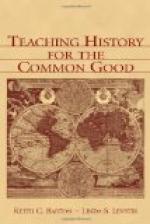The purpose of this monograph is to discuss the means by which the teacher can engender in this student a genuine enthusiasm for the subject, stimulate research and historical judgment, correlate history, geography, literature, and the arts, cultivate proper ideals of government, establish a habit of systematic note-taking, and possibly prepare the student for college entrance examinations.
II
HOW TO BEGIN THE COURSE
Very obviously each moment of the child’s time and preparation should be wisely directed. Each recitation should perform its full measure of usefulness, in testing, drilling, and teaching. There will be no time for valueless note-taking, duplication of map-book work, ambiguous or foolish questioning, aimless argument, or junketing excursions.
What should be done on the day of enrollment
The day that the child enrolls in class should begin his assigned work. In the first ten minutes of the first meeting of the class, while the teacher is collecting the enrollment cards, he should also gather some data as to his students’ previous work in history. This information will be of considerable assistance to the teacher in letting him know what he may reasonably expect of his new pupils. The class should not depart without a definite assignment for the next day. Let the preparation for the first recitation consist in answering such questions as:—
1. What is the
name of the text you are to use? (Know its precise
title.)
2. What is the name, reputation, and position of the author?
3. Of what other books is he the author?
4. Read the preface of the book.
5. What do you
think are the purposes of the subject you are about
to
take up?
6. Give the titles
and authors of other books on the same period of
history.
7. What has been your method of study in other courses of history?
What should be done at the first meeting of the class
On the second day when the class assembles, let as many of the students as possible be sent to the board to answer questions on the day’s assignment. The pupil will immediately discover that the teacher purposes to hold the class strictly responsible for the preparation of assigned work. The teacher will face a class prepared to ask intelligent questions about the course they are entering upon. The class will discover that work is to begin at once. The inertia of the vacation will be immediately overcome.
Necessity for definite instruction in methods of preparing a lesson




